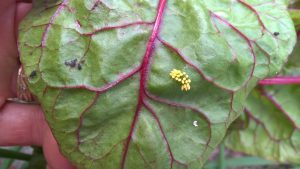The Good, the Bad and the Ugly
July 22, 2017
The Good, the Bad, and the Ugly
Dog days of summer are here. Tomatoes are ripening, zucchinis are looking like footballs and aphids are blanketing the vegetables and flowers. With no rain to help wash the pests off, what’s a gardener to do?
In order to grow plants organically, the first step is to identify the pest that is eating your plant and understand its life cycle.
See chard leaf photo attached. The good – the yellow ladybug eggs. The bad – the white leafminor eggs. The ugly – the black aphids and aphid eggs.
There are many beneficial insects, such as ladybugs and parasitic wasps, that feed on pests. Ladybug eggs will hatch and can eliminate a patch of aphids in no time. It is important to learn what both the eggs and the larvae of these friendly predators look like so that you don’t accidentally kill them.
Aphids are one of the most common pests we find. They come in many colors and attack a huge variety of plants. Aphids are small, soft bodied insects that suck the juices out of stems, leaves and buds. They can reproduce without mating and give birth to live aphids that do not have to pupate. As long as the temperatures are warm enough, they will keep breeding and feeding. They secrete a sticky residue called honeydew that ants love so much that they will protect aphids from predators.
Sun, Aug 20, 2-4, Work Party
Sat, Sep 2, 10-12, Work Party
Sun, Sep 17, 2-4, Work Party
Plus Thursdays 10-12, Food Bank
Another common pest on Swiss chard, beets, spinach and sorrel are the beet and spinach leafminers. Leafminer flies land on the undersides of their preferred plants and deposit tiny pale eggs. The eggs hatch and the larvae mine into the leaf tissue, creating “tunnels.” When the tunnels run into each other, the leaf tissue turns brown and dies. The larvae drop to the ground, pupate and begin another generation of flying adults looking for a place to lay eggs.
Aphids and leafminers can do a lot of damage, but they usually don’t kill plants. Leafminers overwinter in the soil, so I recommend you rotate crops and avoid growing chard and beets in the same bed every year.
 You can tent your plants with fabric (floating row cover) that lets through light, air and rain to help prevent flying insects from landing on plants. Check weekly for eggs and larvae as a few will manage to get into the tent. If eggs hatch and you catch the larvae early, you can lessen the damage by smashing them or dislodge them with a strong spray of the hose. Or, use a soft brush to knock off aphids, larvae or eggs. Harvest damaged leaves, cut away the damaged parts, and eat the rest. More food for you and less for the pest!
You can tent your plants with fabric (floating row cover) that lets through light, air and rain to help prevent flying insects from landing on plants. Check weekly for eggs and larvae as a few will manage to get into the tent. If eggs hatch and you catch the larvae early, you can lessen the damage by smashing them or dislodge them with a strong spray of the hose. Or, use a soft brush to knock off aphids, larvae or eggs. Harvest damaged leaves, cut away the damaged parts, and eat the rest. More food for you and less for the pest!
UC Davis Integrated Pest Management has great photos and information about many insects, good and bad.
Aphids: http://ipm.ucanr.edu/PMG/PESTNOTES/pn7404.html
Leafminers: http://ipm.ucanr.edu/PMG/GARDEN/VEGES/PESTS/vegleafminers.html
Ladybugs: http://ipm.ucanr.edu/PMG/NE/convergent_lady_beetle.html
Parasitic wasps: http://ipm.ucanr.edu/PMG/NE/lysiphlebus_testaceipes.html
Sue Hartman

Wonderful! I especially liked the photo of the leaf! Good to know not to plant swiss chard next year.
Thank you for your kind informative post!
That is one amazing picture!! Thank you:)